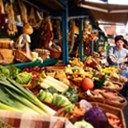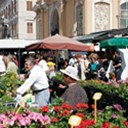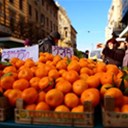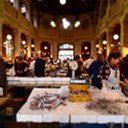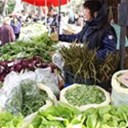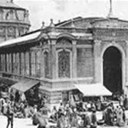The "Belly of the city" - Rijeka's market
If you believe that love goes through the stomach, then Velika placa (Big Market), as Rijeka’s citizens call their central market, is the right place for you!
The pulsating energy of the belly of the city leaves no one indifferent, awakening all your senses and inviting you to surrender to a carefree game of verbal wit and astute choosing, as well as to the excitement of unpredictable shopping and preparing a tasteful meal upon returning home.
A charm of personal contact
There is no supermarket that can replace the charm of personal contact with a salesperson or even better, a home fruit grower, offering produce of not so attractive appearance but hiding all the benefits of original flavours, waiting for true connoisseurs.
It is thus important to have your own salesperson who pick for you only the best or discretely signal what to avoid that day, while their insider information about the daily market offer is priceless: when the fresh fish arrives, where the sweetest cherries can be found, the most tasteful olives, home-grown garlic, unsprayed apples, young chard and how much long you have to wait for prices to go down, because they are not the same in the morning or at noon, at the beginning or in high season for a fruit or vegetable.
The tasteful fruits of the generous nature of the Kvarner area will undoubtedly boost your mood, just like chromotherapy, by mere colours of the seasons, the shift of which is most picturesquely depicted precisely on these geometrically positioned stalls, where despite the seeming chaos of colours, sounds, smells and tastes, rules relaxing harmony.
Tailor-made for urban people
Rijeka’s market place is really tailor-made for urban people, big enough to satisfy gourmet appetites, yet small enough to allow spare time to have a coffee or read newspapers or enjoy small talk with an acquaintance you accidentally meet.
Few know that this dynamic performance, metaphorically situated close to the Ivan pl. Zajc Croatian National Theatre, takes place where once people could literally lose ground under their feet, as the whole area was covered by sea.
In the 19th century it was gradually filled, which we are reminded of today when, during the stormy southern wind (the Jugo) , the surrounding streets and stalls become flooded as sea level rises.
The first lavish kiosks, where the outdoor sales began, were situated under the plane-trees planted in 1861.
At the end of the alley by the sea, the first fish market was built, facing a wooden pier where fishermen used to unload their catch and sell it in baskets.
Towards the end of the 19th century, in the period of the great construction of Rijeka, according to the state-of-the-art architectural solutions of the time applied in the European metropolises such as Trieste, Graz and Vienna, it was decided that the outdoor market be replaced with a covered one, thus providing a more convenient purchase for the citizens as well as a gathering place which would be this littoral town’s forum.
The project of building two covered pavilions was entrusted to the engineer Isidor Vauchnig, Head of the Municipal Civil Engineering Office, and after only a year, in July 1881, the market opened its door in two identical interconnected buildings, with nicely balanced proportions and a barrel vault of a metal grid structure with glass, which was a novelty in architecture, while the decorations of previous, historical styles were retained on the facade.
Situated on the square, the pavilions together with the fish market have become an embellishment of the city and an urban backbone of a new residential district.
The magnificent architecture of the fish market
At the beginning of the 20th century, the existing fish market was no longer in compliance with hygienic standards, so that in 1916, at the same place, a completely new facility was constructed, based on the project of Rijeka’s architect Carlo Pergoli, who was under the influence of the Vienna Secession and some elements of the Romanic style.
The author of the stone decoration is the famous Venice sculptor Urbano Bottasso, who designed a timeless and impressive building with fountains inside the fish market, tables for selling fish made of warm grey Istrian stone, with capitals and rich ornaments on the facade depicting fish, crabs and molluscs in an underwater ecstasy admired by passers-by.
The best way to experience all the architectural grandeur of the interior with real sea food spread out on tables is to go from the back entrance to the gallery on the upper floor.
Apart from the main market place, there is another smaller one, situated in the part of the city called Brajda, also constructed towards the end of the 19th century at the time of Rijeka’s expansion and with the purpose of raising citizens’ standard.
Even this project was taken very seriously and, in terms of urban and architectural design, it was entrusted to the famous Rijeka’s architect Giacomo Zammatio who, very successfully, balanced the aesthetic principles of historicism and the functionality of space, with the old Rijeka’s coat of arms carved above the portal at the main facade facing the sea.
The monumental piece of architecture of the then Central European trendsetting circle is today a protected cultural monument, filled with the life of new generations and natural cycles that alternate assiduously bringing the joys and pleasures of the Mediterranean food to our tables!
Monumental architecture of then Central European jet-set today is the protected cultural monument, full of new generation lives and natural cycles that alternate assiduously, bringing to our tables joy and pleasure of Mediterranean food!
